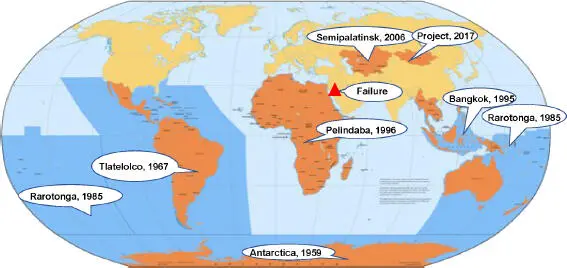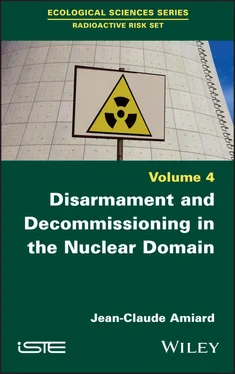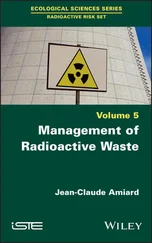States that possess nuclear weapons, or support a policy of deterrence, can no longer afford to question their understanding of nuclear disarmament. The Nuclear Weapons Treaty offers them this opportunity. This norm of international law exists and is likely to enter into force around the 10th NPT Review Conference (scheduled for May 2020, although it has been postponed). The (non-exhaustive) proposals set out in Annex 1 offer some ideas on how to overcome some of the misunderstandings and demonstrate a common will among states to move forward together and create a world free of nuclear weapons [COL 18a].
1.4.3. The Fissile Material Cut-Off Treaty (FMCT)
The treaty banning the production of fissile material or other nuclear explosive devices (FMCT or “ Cut-off ”) is an old draft of the UN General Assembly. It was on December 16, 1993 that this Assembly adopted a resolution (A/RES/48/75L) that called for the opening of negotiations to elaborate such a treaty. The reasoning was simple: stopping the production of fissile materials (military plutonium or 239Pu and highly enriched uranium) constitutes one of the essential locks of nuclear proliferation.
For more than 20 years, the Disarmament Conference (DC) has been working on the text of this treaty. Several drafts have been submitted by France and Canada. However, the impasse in which the DC still finds itself today is due to the abuse of the consensus rule, which allows any state to block the progress of work for any reason whatsoever.
The main causes of divergence on this treaty concern the delimitation of the scope for negotiating this prohibition. Egypt and Pakistan want the stockpiles of nuclear-weapon states (NWS) to be taken into account, which the five strongly reject. China wants to increase its stockpile in the face of India’s expanding stockpile. The same is true for Pakistan with regard to India. France has always been favorable and actively supports the process of creating this treaty, but its stockpile (30.6 tons of highly enriched uranium and 6 tons of plutonium 239) would allow it to produce several thousand nuclear weapons [COL 15]. For nearly 15 years, France has been strongly committed to the negotiation of a treaty banning the production of fissile material for nuclear weapons, known as the Cut-Off Treaty. This is one of the French proposals for disarmament, announced by the President of France in his speech in Istres on February 19, 2015 [FRA 15, FRA 19a].
In spite of this lack of progress, there is hope, however, with the shifting of discussions to the level of the General Assembly. In October 2012, the UN General Assembly voted in favor of a Canadian-sponsored resolution that established a Group of Governmental Experts (GGE) on TIPMF. In 2016, the UN General Assembly adopted another resolution introduced by Canada, and co-sponsored by Germany and the Netherlands, establishing a 25-member High-Level Preparatory Group of Experts (Preparatory Group) to build on the work of the GGE and make recommendations on the substantive elements of a treaty being prepared for negotiation [UN 17a, UN 17b].
At its last meeting in June 2018, the Preparatory Group successfully negotiated a consensus report recommending the elements of a future treaty. The UN Secretary General transmitted this report to the DC in the hope that they will begin formal negotiations on a treaty that will help end the global nuclear arms race [GOU 18].
1.4.4. Regional disarmament treaties
Nuclear-Weapon-Free Zone Treaties represent a regional approach to strengthening international norms for nuclear non-proliferation and disarmament, coupled with the promotion of international peace and security.
In 2016, there were five nuclear-weapon-free zones established under different treaties: (a) Latin America and the Caribbean, under the Treaty of Tlatelolco; (b) the South Pacific, under the Treaty of Rarotonga; (c) Southeast Asia, under the Treaty of Bangkok; (d) Africa, under the Treaty of Pelindaba; and (e) Central Asia, under the Treaty of Semipalatinsk.
The Treaty of Tlatelolco was the first international instrument establishing a nuclear-weapon-free zone in a densely populated part of the world.
In addition to these regional zones, the UN recognized Mongolia’s self-proclaimed nuclear-weapon-free status by adopting the biennial General Assembly resolution entitled “Mongolia’s international security and nuclear-weapon-free status”.
In 2018, the treaties of Tlateloko and Ranotonga were signed and ratified by the five nuclear powers. The treaties of Pelindaba and Central Asia have been signed by all five powers, but the United States (alone) has not ratified them. The Treaty of Bangkok is in the process of being signed. The text of these treaties and the list of countries that have acceded to them are available at: http://disarmament.un.org/treaties/[ONU 18]. The geographic scope of these regional treaties is shown in Figure 1.3.

Figure 1.3. The various regional treaties banning nuclear weapons. For a color version of this figure, see www.iste.co.uk/amiard/disarmament.zip
1.5. Disarmament controls
The best treaty in the world is worthless if it is not respected and if all parties cannot verify its application. All confidence lies in the effective verification of nuclear disarmament. The main role of a verification system is the same for all arms control treaties, namely, to deter cheating [GOL 07]. Depending on the treaties, verification can be carried out at the international level or bilaterally. International controls mainly concern the NPT and CTBT.
1.5.1. Principle and practice of disarmament controls
Disarmament controls are not easy because a large number of factors interfere with them. However, the technologies that serve these controls are increasingly effective.
The verification of nuclear disarmament is influenced by a multitude of factors. First, international politics and inter-state relations play an important role in the design of verification systems, determining which verification techniques can be used and how and when they can be applied. This leads to a compromise between different positions that may not necessarily represent the best technical solution to the various verification problems.
Even within a particular state, different national interest entities may disagree on interpretations and practical aspects of compliance. Some will view violations, or even ambiguities, as clear evidence of deliberate fraud, while others will interpret them as minor and unavoidable oversights or unintended consequences.
In the construction of nuclear verification systems, there is a necessary tension between the levels of intrusiveness and the need to prevent the disclosure of militarily or commercially sensitive information. In the early days of verification, this balance was oriented towards the protection of information, either through the use of national technical means alone, or through a limited number of on-site inspections. Subsequently, verification systems became more intrusive and on-site inspections have become an essential element of nuclear verification regimes, even at sensitive military facilities.
In the context of bilateral disarmament efforts undertaken by the United States and Russia, the potential benefit of fraud through misrepresentation is derisory since both sides have retained large arsenals of nuclear weapons. On the contrary, withholding weapons in small numbers during dismantlement could be a significant strategic advantage for states with limited nuclear arsenals. The case of South Africa’s total nuclear disarmament is a hopeful one [BOW 18].
Читать дальше












